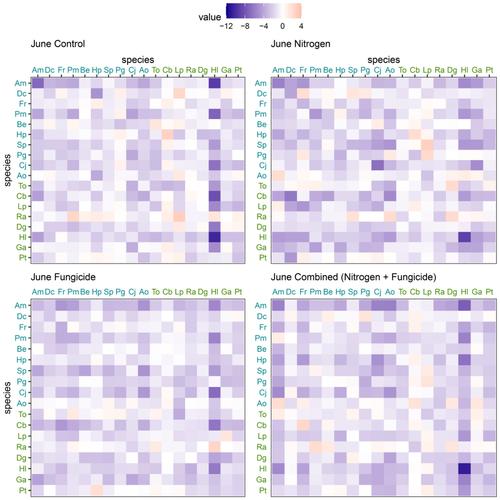当前位置:
X-MOL 学术
›
Ecol. Lett.
›
论文详情
Our official English website, www.x-mol.net, welcomes your feedback! (Note: you will need to create a separate account there.)
Fast–slow traits predict competition network structure and its response to resources and enemies
Ecology Letters ( IF 8.8 ) Pub Date : 2024-04-05 , DOI: 10.1111/ele.14425 Caroline Daniel 1 , Eric Allan 1, 2 , Hugo Saiz 1, 3 , Oscar Godoy 4, 5
Ecology Letters ( IF 8.8 ) Pub Date : 2024-04-05 , DOI: 10.1111/ele.14425 Caroline Daniel 1 , Eric Allan 1, 2 , Hugo Saiz 1, 3 , Oscar Godoy 4, 5
Affiliation

|
Plants interact in complex networks but how network structure depends on resources, natural enemies and species resource‐use strategy remains poorly understood. Here, we quantified competition networks among 18 plants varying in fast–slow strategy, by testing how increased nutrient availability and reduced foliar pathogens affected intra‐ and inter‐specific interactions. Our results show that nitrogen and pathogens altered several aspects of network structure, often in unexpected ways due to fast and slow growing species responding differently. Nitrogen addition increased competition asymmetry in slow growing networks, as expected, but decreased it in fast growing networks. Pathogen reduction made networks more even and less skewed because pathogens targeted weaker competitors. Surprisingly, pathogens and nitrogen dampened each other's effect. Our results show that plant growth strategy is key to understand how competition respond to resources and enemies, a prediction from classic theories which has rarely been tested by linking functional traits to competition networks.
中文翻译:

快慢特征预测竞争网络结构及其对资源和敌人的反应
植物在复杂的网络中相互作用,但网络结构如何依赖于资源、天敌和物种资源利用策略仍然知之甚少。在这里,我们通过测试增加养分可用性和减少叶面病原体如何影响种内和种间相互作用,量化了 18 种不同快慢策略的植物之间的竞争网络。我们的结果表明,氮和病原体改变了网络结构的几个方面,由于快速和缓慢生长的物种反应不同,通常以意想不到的方式改变。正如预期的那样,氮的添加增加了缓慢增长的网络中的竞争不对称性,但减少了快速增长的网络中的竞争不对称性。病原体的减少使网络更加均匀且不那么扭曲,因为病原体针对的是较弱的竞争对手。令人惊讶的是,病原体和氮相互抑制了彼此的作用。我们的结果表明,植物生长策略是理解竞争如何对资源和敌人做出反应的关键,这是经典理论的预测,但很少通过将功能性状与竞争网络联系起来进行测试。
更新日期:2024-04-05
中文翻译:

快慢特征预测竞争网络结构及其对资源和敌人的反应
植物在复杂的网络中相互作用,但网络结构如何依赖于资源、天敌和物种资源利用策略仍然知之甚少。在这里,我们通过测试增加养分可用性和减少叶面病原体如何影响种内和种间相互作用,量化了 18 种不同快慢策略的植物之间的竞争网络。我们的结果表明,氮和病原体改变了网络结构的几个方面,由于快速和缓慢生长的物种反应不同,通常以意想不到的方式改变。正如预期的那样,氮的添加增加了缓慢增长的网络中的竞争不对称性,但减少了快速增长的网络中的竞争不对称性。病原体的减少使网络更加均匀且不那么扭曲,因为病原体针对的是较弱的竞争对手。令人惊讶的是,病原体和氮相互抑制了彼此的作用。我们的结果表明,植物生长策略是理解竞争如何对资源和敌人做出反应的关键,这是经典理论的预测,但很少通过将功能性状与竞争网络联系起来进行测试。



























 京公网安备 11010802027423号
京公网安备 11010802027423号